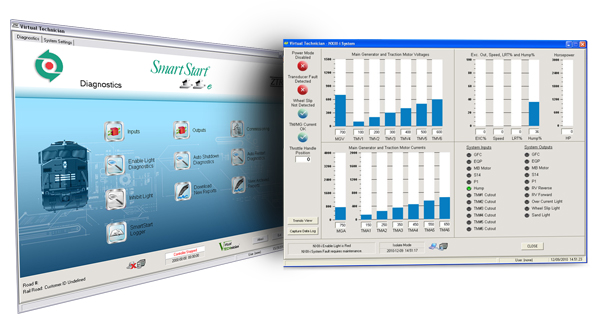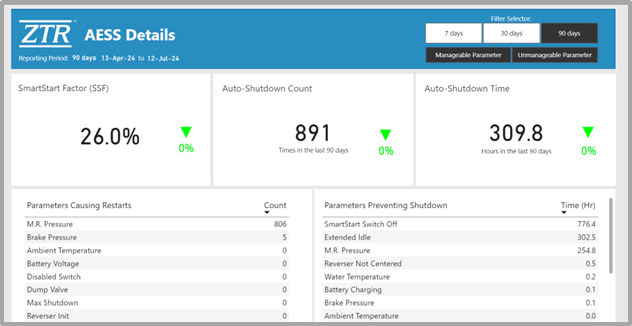In the rail industry, efficiency and cost-effectiveness are crucial for maintaining competitive operations. One significant area of focus is fuel management, where even minor improvements can result in substantial cost savings and environmental benefits. Automatic Engine Stop-Start (AESS) systems, such as SmartStart, have emerged as essential tools in this domain. But how do you know if your locomotives could benefit from an AESS system?
Understanding AESS Systems
AESS systems, like SmartStart, automatically shut down and restart locomotive engines based on critical operational parameters. By monitoring factors such as engine temperature, battery voltage, and overall system health, these systems ensure that engines are only running when necessary. This reduces idling time, conserves fuel, and minimizes engine wear and tear.
What is an AESS System?
An Automatic Engine Stop-Start (AESS) system is a technology designed to reduce unnecessary idling in locomotives. It achieves this by monitoring key operational parameters and deciding when to shut down or restart the engine. This ensures that the engine runs only when needed, optimizing fuel use and reducing emissions.
How Does SmartStart Work?
SmartStart, a leading AESS system, uses microprocessor technology to monitor various engine parameters. When conditions are optimal, it shuts down the engine to conserve fuel. It then restarts the engine when necessary, such as when the temperature drops below a certain threshold or when battery voltage decreases.
The Evolution of AESS Systems
Over the past 30 years, AESS systems, including SmartStart, have evolved significantly. Early systems were relatively basic, focusing primarily on reducing idling. Modern systems like SmartStart IIe, however, offer advanced features such as remote monitoring, GPS location tracking, and integration with auxiliary power units (APUs) for even greater fuel savings.
When to Consider an AESS System
Determining whether your locomotives could benefit from an AESS system involves analyzing several key factors. Here are some situations where implementing an AESS system could be particularly beneficial.
High Fuel Consumption
If your locomotives are consuming large amounts of fuel, particularly during idling periods, an AESS system can provide immediate and measurable benefits. Reducing idle time directly translates to fuel savings, which can significantly impact your operating costs.
Regulatory Compliance
Operators facing stringent emission regulations can benefit from the compliance features of AESS systems. These systems help ensure that locomotives meet required standards, reducing the risk of fines and improving your company's environmental footprint.
Frequent Idle Times
Locomotives that experience extended idle times, whether in yards or at stations, are ideal candidates for AESS systems. Reducing idle times directly correlates with fuel savings and reduced emissions, making AESS systems a smart investment.
Aging Fleet
Older locomotives may benefit significantly from the updated technology an AESS system provides. It can help improve reliability and reduce maintenance costs by minimizing wear and tear due to excessive idling.
Cost Management
Implementing an AESS system can lead to considerable cost savings in terms of fuel expenses and maintenance. For companies looking to optimize their budgets, this can be a crucial factor.
Environmental Initiatives
Companies committed to sustainability and reducing their carbon footprint will find AESS systems invaluable. These systems help minimize emissions, contributing to cleaner air and a healthier environment.
Operational Efficiency
An AESS system can help streamline operations by reducing unnecessary idle times and enhancing overall efficiency. This leads to better resource management and improved scheduling flexibility.
Noise Reduction
In areas where noise pollution is a concern, such as urban environments or residential areas, AESS systems can significantly reduce idle noise, making operations more community friendly.
Key Benefits of Implementing an AESS System
Implementing an AESS system offers numerous benefits beyond just fuel savings. Here are some of the most significant advantages.
Fuel Savings
The primary advantage of AESS systems is significant fuel savings. For instance, SmartStart has been shown to save up to 8,000 gallons of fuel per year per locomotive. This reduction in fuel consumption translates to substantial cost savings, which can quickly offset the initial investment in the technology.
Reduced Emissions
AESS systems help rail operators meet stringent environmental regulations by reducing greenhouse gas emissions. SmartStart, for example, offers comprehensive EPA compliance reporting, making it easier for operators to adhere to emission standards and avoid potential fines.
Operational Efficiency
Beyond fuel savings, AESS systems improve overall operational efficiency. SmartStart's remote monitoring and reporting capabilities enable real-time tracking of locomotive performance, allowing for proactive maintenance and operational adjustments. This not only enhances reliability but also extends the lifespan of locomotives.
Engine Health Management
AESS systems monitor the health of the engine and prevent issues such as battery depletion, ensuring that the locomotive is always ready for operation. This reduces the likelihood of unexpected breakdowns and associated downtime, leading to more reliable service.
Cost-Effective Integration
Modern AESS systems, including SmartStart, are designed to be compatible with a wide range of locomotive models. This versatility means that rail operators can implement the system across their fleet without significant modifications or additional costs, making integration straightforward and cost-effective.
Operational Data Needs

For operators seeking to leverage data for better decision-making, the remote monitoring and reporting capabilities of AESS systems like SmartStart provide valuable insights into locomotive performance and fuel efficiency. This data can be used to optimize operations, reduce costs, and improve overall performance.
Real-Time Monitoring
AESS systems offer real-time monitoring of locomotive performance, providing operators with up-to-date information on fuel consumption, engine health, and other critical parameters. This allows for proactive maintenance and operational adjustments, reducing downtime and improving efficiency.
Data-Driven Decision Making
The data collected by AESS systems can be used to make informed decisions about fleet management, maintenance schedules, and operational strategies. This data-driven approach helps operators optimize their operations, reduce costs, and improve overall performance.
Enhanced Reporting
AESS systems like SmartStart offer comprehensive reporting features, allowing operators to track fuel savings, emissions reductions, and other key metrics. These reports can be used to demonstrate compliance with regulatory requirements, justify investments in new technology, and identify areas for further improvement.
Environmental Initiatives
Companies with strong environmental policies will benefit from the reduced emissions and fuel consumption provided by AESS systems. This aligns with sustainability goals and can improve the company’s public image.
Supporting Sustainability Goals
Implementing an AESS system can help rail operators support their sustainability goals by reducing fuel consumption and greenhouse gas emissions. This not only benefits the environment but also enhances the company's reputation as a responsible and forward-thinking organization.
Improving Public Image
Companies that prioritize environmental sustainability can improve their public image and attract environmentally conscious customers and investors. By implementing an AESS system, rail operators can demonstrate their commitment to sustainability and position themselves as leaders in the industry.
Meeting Regulatory Requirements
AESS systems help rail operators meet stringent environmental regulations by reducing emissions and providing comprehensive compliance reporting. This reduces the risk of fines and penalties and ensures that the company remains in good standing with regulatory authorities.
Cost Reduction Strategies
Businesses focused on reducing operational costs will find AESS systems valuable. The fuel savings alone can offset the initial investment within a relatively short period, making AESS systems a smart financial decision.
Immediate Cost Savings
Implementing an AESS system can result in immediate cost savings by reducing fuel consumption and minimizing engine wear and tear. These savings can quickly offset the initial investment in the technology, making it a cost-effective solution.
Long-Term Financial Benefits
In addition to immediate cost savings, AESS systems offer long-term financial benefits by extending the lifespan of locomotives, reducing maintenance costs, and improving overall operational efficiency. These benefits contribute to a healthier bottom line and a more sustainable business model.
Enhanced Return on Investment
The combination of immediate and long-term cost savings makes AESS systems a valuable investment for rail operators. By improving fuel efficiency, reducing emissions, and enhancing operational efficiency, AESS systems offer a strong return on investment and support overall business goals. The typical breakeven period for a SmartStart investment is well under a year, making it an even more attractive option for operators looking to optimize their resources.
Fleet Modernization

Rail operators looking to modernize their old fleet with the latest technology should consider AESS systems. These systems are compatible with a wide range of locomotive models, making integration straightforward and cost-effective.
Upgrading to Modern Technology
Implementing an AESS system is an effective way to modernize your fleet and take advantage of the latest technology. This not only improves operational efficiency but also ensures that your fleet remains competitive in the market.
Compatibility and Integration
Modern AESS systems, such as SmartStart, are designed to be compatible with a wide range of locomotive models. This versatility makes integration straightforward and cost-effective, allowing rail operators to implement the system across their fleet without significant modifications.
Future-Proofing Your Fleet
By investing in AESS systems, rail operators can future-proof their fleet and ensure that they are prepared for evolving industry standards and regulations. This proactive approach helps operators stay ahead of the competition and maintain a strong market position.
What should you do?
In the competitive and cost-sensitive rail industry, every efficiency gain counts. AESS systems offer a proven solution for reducing fuel consumption, lowering emissions, and improving overall operational efficiency. With their ability to monitor and manage engine health, prevent battery depletion, and provide regulatory compliance reporting, systems like SmartStart present a compelling case for any rail operator looking to optimize their locomotive operations. If your locomotives are experiencing high fuel consumption, frequent idle times, or stringent emission regulations, investing in an AESS system could be a transformative decision for your business.
For more information on SmartStart and how it can benefit your rail operations, read more about it here, and consider scheduling a consultation with one of our experts. Discover how an advanced AESS can help you achieve your efficiency, sustainability, and cost reduction goals.